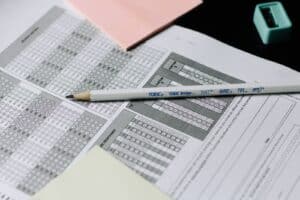How is the GED scored? The GED, or General Educational Development, is a high school equivalency test that measures knowledge and skills in four subject areas: math, science, social studies, and language arts. The GED test is used to determine if an individual has the equivalent knowledge and skills of a high school graduate.
The GED scoring system is designed to evaluate an individual’s knowledge and skills in these four subject areas. Each subject test is scored on a scale of 100-200 points. To pass the GED test, an individual must achieve a score of 145 or higher on each subject test. The overall passing score for the GED test is 580 or higher, which is the sum of the scores from all four subject tests.
It’s important to note that the GED test is now computer-based, so the scores are provided immediately after the test, and the GED Testing Service will mail the official score report to the test taker within 3 weeks of taking the test.
GED Scores and Their Significance

GED scores are the numerical representations of a test-taker’s performance on each of the subject sections. Each subject is assessed on a scale ranging from 100 to 200 points. In order to pass the GED test successfully, a minimum score of 145 is required for each individual subject. This culminates in an overall passing score of 580 or higher, which is the sum of the scores obtained in all four subject areas.
The Process of GED Scoring
The computation of GED scores hinges on the number of questions answered accurately in each respective subject section. Every subject test comprises two parts, each contributing half to the total score of that particular subject. For instance, if a test-taker attains a score of 150 in a subject, it signifies that they responded correctly to 75 questions in each section of the test.
The scoring methodology utilized by the GED test involves a statistical technique called “equating.” This process guarantees that scores from different versions of the GED test are equitable in terms of complexity and content. Therefore, scores achieved in one test version can be reliably compared to those attained in another version.
Scaling for Fairness and Consistency
Another essential aspect of GED scoring is “scaling,” which adjusts scores to accommodate disparities in difficulty across various test versions. Scaling ensures uniformity in scores across different test forms, thereby maintaining the consistency of passing scores across tests.
How is the GED scored? – Interpreting GED Scores and Receiving Results
Once the computer-based GED test is concluded, results are promptly accessible. The official score report, provided by the GED Testing Service, is typically dispatched within three weeks after completing the test. This report outlines scores for each individual subject, along with an aggregate overall score.
Understanding Your GED Score Report
The GED score report not only presents scores but also elucidates their meaning. Test-takers can observe their individual scores for each subject, contrasting them against the minimum passing scores. This facilitates self-assessment to determine whether the test has been successfully passed.
The score report augments its utility by providing insights into score interpretation. It might delineate the level of knowledge and skills corresponding to distinct score ranges. This insight enables individuals to identify strengths and weaknesses, aiding them in focusing their efforts on areas necessitating improvement.
If a test-taker does not attain the required passing scores, there is a possibility of retaking the test after the prescribed waiting period, which varies among states. Engaging in effective test preparation through resources like study materials, practice questions, and test prep courses can significantly enhance the potential for score improvement.
Test Preparation and Tips for Success

Preparing for the GED exam entails honing skills across the subjects of mathematical reasoning, science, social studies, and language arts. Engaging in practice questions, utilizing official GED test preparation materials, and considering test prep courses can amplify one’s chances of success.
Effective Preparation Techniques
To optimize your preparation for the GED exam, it’s recommended to acquaint yourself with the content and structure of the test for each subject domain. Adopting a strategic approach entails dedicating ample time to focused study sessions, honing your skills through sample questions, and seeking reinforcement from online resources and study groups.
Navigating the GED Exam Landscape
Facing the GED exam requires a well-structured plan that aligns with your strengths and areas that need improvement. As you prepare for this significant milestone, consider the following strategies to navigate the exam landscape with confidence and competence:
Customized Study Schedule
Craft a study schedule tailored to your learning style and commitments. Allocate time for each subject, ensuring a balanced approach that allows for comprehensive coverage. By breaking down the material into manageable segments, you’ll prevent overwhelm and foster consistent progress.
Practice Makes Progress
Engage in regular practice sessions with sample questions and mock tests. This approach not only acquaints you with the format of the questions but also hones your time management skills. As you analyze your performance, pinpoint areas that require more attention and dedicate focused study sessions to strengthen them.
Leveraging Online Resources

Harness the power of online resources to enhance your preparation journey. Explore interactive tutorials, video lessons, and digital study groups. These platforms provide dynamic learning experiences and the opportunity to engage with fellow test-takers, fostering a collaborative environment for knowledge exchange.
Expert Guidance through Test Prep Courses
Consider enrolling in official GED test prep courses. These courses offer structured guidance from experienced instructors who are well-versed in the exam’s nuances. With their expertise, you’ll receive targeted instruction, personalized feedback, and a deeper understanding of the subjects, ultimately boosting your confidence for the exam day.
Holistic Approach to Wellness
Remember that a holistic approach to preparation encompasses physical and mental well-being. Prioritize sufficient sleep, balanced nutrition, and exercise to ensure optimal cognitive function. Managing stress through relaxation techniques and positive visualization can further contribute to a focused and clear mindset on exam day.
Benefits of GED Certification
Achieving a passing GED score opens doors to numerous opportunities. It not only validates one’s academic proficiency but also paves the way for pursuing higher education, including college courses. A GED diploma holds the same worth as a traditional high school diploma, enabling individuals to embark on a journey towards personal and professional growth.
In conclusion, the journey to attaining a GED diploma requires dedication, preparation, and the pursuit of knowledge. By understanding the scoring process, interpreting score reports, and investing in effective test prep, individuals can navigate the GED exam with confidence, achieving success and opening doors to a brighter future.
Achieving Success in GED: Tips for Effective Preparation
Preparing for the GED demands a strategic approach tailored to individual learning styles and commitments. Embracing diverse study materials, including official GED test prep resources and online courses, can significantly enhance readiness. Practice questions in math, science, social studies, and language arts provide invaluable insight into the test’s structure and aid in refining problem-solving skills. Moreover, creating a personalized study schedule that allocates focused time to each subject fosters a balanced approach to comprehensive preparation.
Understanding the reasoning behind the GED test sections is crucial. Each section assesses specific cognitive abilities, such as critical thinking, analysis, and logical reasoning. Diving into the nuances of these skill sets can empower test-takers to approach questions strategically, ensuring a deeper comprehension of concepts rather than rote memorization. By incorporating diverse practice tests and delving into the reasoning behind correct answers, individuals can elevate their proficiency and readiness for the exam.
Beyond Passing: The Impact of GED Certification

Earning a GED diploma extends far beyond meeting minimum score requirements. It stands as a testament to one’s dedication, perseverance, and commitment to academic excellence. This school equivalency certification opens doors not only to higher education but also to diverse career opportunities that require a high school diploma or its equivalent. In many states, a GED diploma holds the same value as a traditional high school diploma, enabling access to college courses and vocational programs.
The journey doesn’t end with passing the GED; it’s a gateway to continued growth. Individuals equipped with a GED diploma can pursue higher education, explore career pathways, and expand their horizons. Whether aiming for college enrollment or seeking career advancement, the GED diploma serves as a stepping stone toward personal and professional fulfillment.
Navigating State-Specific GED Tests and Results
Understanding the variability among states in terms of GED test requirements and waiting periods for retakes is pivotal. Each state might have specific guidelines regarding eligibility criteria, test fees, and the number of retakes allowed. Familiarizing oneself with these state-specific details ensures a smoother journey through the testing process.
Moreover, comprehending how GED results are interpreted and applied across different states is essential. While the scoring system remains uniform, states might have varying policies on recognizing GED diplomas for college admissions or employment opportunities. Exploring the specifics in each state aids test-takers in making informed decisions about their educational and career pathways.
By staying informed about state regulations and interpreting GED scores in the context of different regions, individuals can navigate the GED landscape more confidently, making informed decisions about their educational and professional future.
